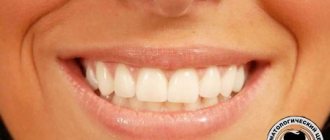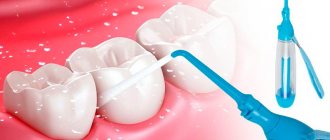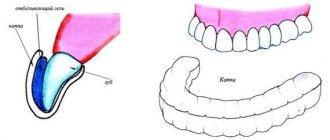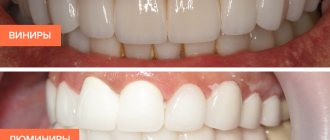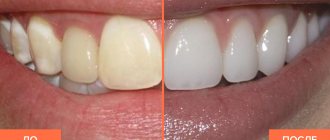This is a relatively new direction in dentistry, the goal of which is to preserve severely damaged teeth, restore their functions and appearance.
The main features of this type include:
- The inlays and onlays used are made in the laboratory individually for each client and are very reliable and durable designs.
- High aesthetics. After all the operations, you are simply guaranteed a flawless smile.
- This procedure uses special tools and equipment that allow you to work in a gentle manner and not affect adjacent teeth.
Designs for microprosthetics
Microprosthetics can be performed using the following structures:
- Tabs.
These are a kind of special fillings, they are made in the laboratory and allow you to achieve high aesthetics. Inlays are more reliable and durable than conventional fillings. - Veneers
or onlays are thin plates; they perform a protective function, hide visible defects and significantly improve the appearance of teeth. - Lumineers
are thin porcelain overlays on teeth that are a variation of the previous plates. The main difference is that veneers have a different design. They have significant differences in size, manufacturing methods, strength and durability. Lumirs can be removed. - Ultraneers
are very thin plates that allow you to quickly and effectively restore and correct the front teeth. Ultraneers create a whitening effect and are the most innovative way to restore teeth. - It is also worth noting the use of dental crowns in fixed prosthetics. This method has become very popular and is in great demand among all segments of the population.
Microprosthetics in dentistry
This technological direction has a number of advantages over other methods. Teeth are restored in a gentle way, in most cases without damaging those nearby.
The structures that are used for such prosthetics, such as inlays and onlays, are made from casts. They are much stronger and also more durable than photo fillings or crowns.
In this way, you can achieve a flawless, “Hollywood” look to your teeth. This is proven by various photos of microdental prosthetics, which can be seen on the website of the Implantmaster clinic, as well as on other resources on the Internet.
E-max crowns
All-ceramic crowns allow you to restore the shape of a damaged tooth, either partially or completely. Fragmented crowns are used to replace a damaged part of a tooth and restore its functionality. E-max systems can be installed on both chewing and anterior teeth due to the fact that ceramics do not oxidize and do not change color.
Crowns made of E-max material are often used for prosthetics on an implant implanted in the bone. Ceramics are perceived by the body as natural enamel - this guarantees full biological compatibility and allows the use of such crowns by patients who are prone to allergies. The junction of the gum and the veneer or
E - max
crown does not change, since the ceramic edge does not come into contact with body fluids.
Many people are concerned that ceramic crowns or veneers will require complex care. In fact, keeping the E-max system clean is very easy - teeth are brushed just like natural ones. Since the structure of pressed ceramics has no pores, deposits do not form on veneers and crowns and tartar does not accumulate. Experts recommend every six months , and also not neglecting professional oral hygiene.
E-max crowns are made individually for each patient - for this, the dental technician uses ceramic blanks, from which elements are formed in accordance with the necessary parameters - bite, size, color. Ceramic crowns made from E-max material are the best choice if you want to forget about dental problems for a long time; the crowns are guaranteed to last you for decades.
The dentists at the VivaDent clinic invite you to take the first step towards a beautiful smile and comfort.
Our team of doctors
Maxillofacial surgeon, Implantologist
Bocharov Maxim Viktorovich
Experience: 11 years
Dental surgeon, Implantologist
Chernov Dmitry Anatolievich
Experience: 29 years
Orthopedist, Neuromuscular dentist
Stepanov Andrey Vasilievich
Experience: 22 years
Endodontist, Therapist
Skalet Yana Alexandrovna
Experience: 22 years
Orthopedic dentist
Tsoi Sergey Konstantinovich
Experience: 19 years
Dentist-orthodontist
Enikeeva Anna Stanislavovna
Experience: 3 years
MICRO-DENTAL PROSTHETICS
Microdental prosthetics is a separate complex of modern orthopedic dentistry, which involves restoring the functionality and appearance of partially damaged teeth. The main goal of micro dentures is to carry out restoration with minimal trauma to natural teeth and with maximum aesthetic results.
Veneers price from: 20,000 rub.
service life: 10-15 years. Lumineers price from: 55,000 rub. service life: up to 20 years.
Inlays for teeth price from: 15,000 rub. service life: 5-8 years.
Dentures with micro-locks price from: 45,000 rub. service life: 7-10 years.
The content of the article:
- In what cases are microprostheses used?
- The process of manufacturing and installing microprostheses
- Types of microprostheses
- Cost of microdental prosthetics
- What are the alternatives to microdental prosthetics?
Indications for microprostheses
- partially destroyed top of the tooth, but not more than 50%;
- chips, cracks in tooth enamel;
- discoloration of teeth that cannot be whitened;
- increased sensitivity of enamel, weak enamel, abrasion of enamel;
- presence of gaps between teeth;
- slight change in position or crookedness of some teeth
- insufficiently aesthetic teeth for a number of other reasons.
Microprosthetics process
Microdental prosthetics is essentially a high-tech and modern process of restoration and restoration of partially destroyed teeth. During preparation and actual treatment, the patient will have to visit his doctor several times, since the process of restoring the appearance and shape of the teeth is quite labor-intensive. In addition, in cases of aesthetic restoration of anterior teeth, several additional adjustment visits may be required to bring the appearance of the dentures to perfection. In general, the standard scheme for microdental prosthetics consists of the following main stages:
- developing a treatment plan, choosing a method for restoring teeth;
- preparing the oral cavity for treatment: it is important to remove carious cavities, eliminate all existing problems with the tooth that is to be restored;
- preparing the tooth for restoration: the tooth is ground, prepared - it is given a special shape that will allow the prosthesis to be securely fixed for many years; in some cases, the surface of the tooth is simply ground for reliable fastening of the prosthesis;
- after the manufacture of an individual microprosthesis, it is fixed on the tooth; when correcting the anterior teeth using onlays (veneers, lumineers, ultraneers), the prostheses can be fixed temporarily to give the patient the opportunity to evaluate the aesthetic properties and comfort of the prostheses before permanent fixation;
- if necessary, the shape and color of the prostheses are adjusted.
Depending on the chosen method of dental restoration, treatment can last from several days to several weeks - this time is required for the manufacture of an individual prosthesis and its subsequent installation; in the case of using Cerinate lumineers, it also takes a lot of time to send impressions and finished prostheses from the USA to Russia.
Materials for microprostheses on teeth
Most often, solid dental ceramics are used to make microprostheses, since it allows you to create prostheses that are closest to natural dental tissue in terms of aesthetic properties and strength. When making ceramic dentures, it is recommended to use computerized CAD/CAM equipment, which allows you to automatically turn dentures from a single piece of ceramic. This method of manufacturing dentures significantly reduces the time of prosthetics, the manual labor of the technician and, as a result, errors and inaccuracies in the manufacture of microprostheses. However, at the final stage of creating dentures, manual processing is necessary so that the dental technician can give the denture the most natural appearance. Such delicate aesthetic work requires high qualifications and experience of both the dental technician and the orthopedist.
Ceramic materials can come from different manufacturers and, accordingly, have different strengths and costs. The highest quality brands offer a wide range of shades, varying degrees of transparency (depending on the needs of the clinical case) and maximum strength, which ensures maximum service life. Such ceramics are intended for robotic milling using special expensive equipment, so not all clinics can offer their patients high-quality microprostheses. In addition to ceramics, other materials can be used, for example, zirconium dioxide, aluminum oxide, composite materials and even ordinary acrylic plastics, it all depends on the needs of the patient and the chosen method of microdental prosthetics.
Types of microprosthetics
Veneers and Lumineers
This is a modern method of restoring the aesthetics of the dentition. Veneers or their more expensive but high-quality analogues - lumineers - are thin ceramic overlays that are fixed on the front, outer side of the teeth. Accordingly, their function is exclusively aesthetic, since they allow you to hide all external imperfections of the teeth: chips, cracks, stains and discoloration of the enamel, gaps between the teeth and even small curvatures.
Cerinate lumineers are a patented American technology that does not require grinding of teeth to install the prosthesis; only surface grinding of the enamel is sufficient, since the prosthesis is made ultra-thin from special high-strength ceramics (porcelain). These lumineers are manufactured exclusively in the USA, so the prosthetic period can take up to several weeks due to the need for international shipping. However, there are analogs of lumineers that can be manufactured in Russia, if the clinic has special equipment and qualified specialists. Such ultra-thin veneers are called ultra-veneers.
Most often, solid ceramics are used to make veneers, but it is also possible to use veneers based on zirconium dioxide and aluminum oxide, which are more durable. In order to choose the material that is right for you, consult with an orthopedic dentist.
Dental inlays and onlays
Inlays and onlays are large fillings, but they are created not in the oral cavity, but in a dental laboratory using previously taken impressions. They are effective in cases where it is impossible to place a filling - after treatment of the disease, a cavity has formed too large, and the filling will not be securely fixed in the cavity. But it is still too early to fix the crown - the tooth is not destroyed to such an extent, and there is no point in substantially grinding it down for a crown, especially if the roots of the tooth are healthy. It is in such intermediate cases that inlays and onlays, which are made from ceramics, come to the rescue. They are very durable and aesthetic.
There are other materials used to make inlays and onlays, but ceramics are considered the most optimal for such partial restorations. The second most popular material for making inlays and onlays is composite, which is stronger than that used for conventional fillings. Such a tooth restoration will cost less than a ceramic one, but in terms of service life such a prosthesis is significantly inferior to a ceramic one.
Microprosthetics with adhesive prostheses
The adhesive system for fastening bridges is used to restore a missing tooth (maximum of two teeth in a row) and allows you to avoid damaging the supporting teeth. The fixation method is very simple: the empty space is replaced with a dental crown made of composite. With standard dental bridge prosthetics, the two outer teeth are significantly prepared, because the outermost crowns in the prosthesis will be fixed on them. These teeth will be supporting teeth and, alas, no longer alive, since they will need to be depulped. But they do not need to be ground down - instead, in the design of the prosthesis, thin plates are created along the edges, which are glued to the inside of the supporting living teeth (adhesive fastening). The adhesive system helps protect them from damage. But, naturally, there are a number of shortcomings, the main ones being insufficiently reliable fixation and the fragility of the structure. Alas, an adhesive prosthesis will last no more than two to three years if handled with the utmost care.
Microprosthetics using pins
Restoring the crown of a tooth using a pin is also referred to as microdental prosthetics. Pins are metal products that are fixed in the root of the tooth. Naturally, before this, a procedure is performed to remove the nerve. Metal pins are necessary to strengthen the tooth in case of significant destruction of its apex; they serve as a support for further restoration with a crown or composite material.
Prosthetics with micro-locks
Microlocks are another option for fixing a single dental crown or bridge without grinding down natural teeth. In this case, the fastening system consists of two parts: one part of the lock is located inside the supporting tooth (due to the small size of the lock, the tooth is practically not injured), the other part is on the prosthesis. Such dentures belong to the clasp method of dental prosthetics.
Removable microprosthetics
Microprosthetics also often include removable dentures for 1-2 teeth, which are usually used as temporary (for example, before implantation). Otherwise, such prostheses are called “butterflies”. A removable butterfly crown can be made from various materials: acrylic, nylon or quadrotti.
Modern methods of microdental prosthetics make it possible to restore partially destroyed or unaesthetic teeth without grinding, with their maximum preservation.
Microdental prosthetics: cost
The cost of microprostheses varies significantly depending on the chosen method and material. The most economical ones will be acrylic prostheses or adhesive composite bridges. Such structures are most often used as temporary ones before permanent prosthetics - implantation or installation of a dental bridge.
Dental restoration using inlays and onlays is classified as an average price category; the total cost of treatment will depend on the quality of the ceramics, as well as the degree of damage to the tooth (in addition to treating the tooth cavity, root canal treatment may also be required, which will significantly affect the final amount). The same can be said about restoring teeth using pins and stump inlays, but in this case the cost also depends on the type of dental crown.
The most expensive type of microprosthetics is the aesthetic restoration of the smile area using veneers, lumineers or ultraneers, since to create a Hollywood smile, a minimum of 4 veneers are usually installed, and the maximum is the entire visible smile area. However, if only one tooth needs to be corrected, only one veneer can be installed. To understand how many microprostheses will be needed to create an even, beautiful dentition, without forgetting about the correct bite, you need to consult with an orthopedic dentist who specializes in installing microprostheses. If lumineers and ultraneers are made from special ultra-thin and durable porcelain (ceramics), then when choosing veneers it is also possible to use aluminum oxide and zirconium dioxide, which are more expensive materials compared to ceramics.
The patient can obtain more detailed information about the cost of various options for microdental prosthetics for each specific clinical case at a free consultation on dental prosthetics at one of the Association’s clinics. Based on the results of the visit, the patient will receive possible treatment plans to choose the most suitable prosthetic option.
Types of microprosthetics
Due to the wide scope of application of this technique, several varieties are used.
- Prosthetics using pins - this method restores a damaged crown, provided that the tooth root is still healthy. A pin is inserted into the root, onto which a new crown is already attached. In this case, neighboring teeth are not damaged or ground down.
- Prosthetics with onlays, or veneers, allow you to restore the aesthetic appearance, improve the shape and color. Overlays, in the form of thin plates, about 0.5 mm thick, are installed in areas of chipping, darkening or abrasion of the enamel. Thus, the destruction of the dentition from external influences such as cigarette smoke, coffee, tea, as well as physical damage is prevented. Veneers are typically made from zirconia ceramic or porcelain. These onlays come in three varieties - lumineers, porcelain onlays and composite veneers.
- Prosthetics with inlays, stumps and restorations - used in case of caries, closing the root canal after treatment, instead of fillings. Tabs restore the chewing surface. Restorative ones correct the shape and color, stump ones restore the coronal part. Such fillings are made in special laboratory conditions; they are much stronger and more durable than other types. In addition, they look very aesthetically pleasing.
- Adhesive microprosthetics of a missing tooth - in this case it is replaced with a prosthesis. It is made using elastic fiberglass or plastic, which have very high strength. On its basis, a prosthesis in the form of a bridge with a long service life is manufactured. The fiberglass bar is attached, using adhesive, to the adjacent teeth. For this purpose, small notches are made on their surface, less than 2 mm deep. A prosthesis is formed on the beam by polymerizing a special material under the influence of light. This technique is recommended for those people who are allergic to the metal used in dentures.
Varieties
To restore teeth in a dental clinic, several types of microprosthetics are used.
Adhesive bridge
If one element is missing from the dentition, it is reanimated using the adhesive method using a beam or fiberglass tape. On the chewing side of the supporting incisors, depressions are made in the enamel, into which special material is placed. It is treated with adhesives and becomes very durable. An artificial tooth is formed on a beam or strip using photopolymers or a component is selected from a ready-made set. This method has an optimal balance between quality and cost.
Overlays and inlays
Restorative inlays are suitable for a tooth that is no more than half destroyed. They help restore shape, function and color. They are made from different materials (cobalt-chrome alloy, gold, ceramics and zirconium oxide) according to the shape of the missing part of the tooth and are securely fixed to the remaining surface. Onlays perform the same functions, but cover most of the damaged incisor.
Stump inlays
This type of microprosthetics is used when the tooth has thin walls or is more than half destroyed. The structure is made of durable material and formed according to an individual cast. It contains a pin (root part) and a crown. This model is quite reliable and is also suitable for bridge prosthesis.
Lumineers and veneers
Such onlays are used if there are cracks in the teeth, they quickly wear out or are of the wrong length and shape, as well as if the enamel is chipped.
Veneers are the thinnest ceramic plates (0.5 mm) that are fixed to the front part of the dentition with glue.
Lumineers are an ultra-thin plate (0.2-0.3 mm) made of ceramic. In terms of their properties, they are most closely similar to natural enamel.
Microprosthetics with veneers and lumineers are considered the most gentle method. The surface covered with them is no different from the natural dentition.
How microprostheses are installed
Many naively believe that microprosthetics are performed quickly, in 1-2 visits to the attending physician. In fact, this is completely wrong. This procedure is performed in several stages.
- An initial examination, the purpose of which is to determine the condition of the oral cavity, as well as to identify diseases that may interfere with this method of treatment. If any of the diseases is detected, it is necessary to treat it, which can take quite a long time.
- Preparing and taking an impression – after treatment, the tooth is processed. The top layer of enamel is ground down to install the lining, or the place where the chewing surface is destroyed is undermined. An impression is made using plaster, and a temporary veneer is installed for the patient.
- After a few days, the finished microprosthesis is checked and further processed if necessary.
- Finally, it is installed in place using cement.
Indications and contraindications
Microprosthetics of the dentition is indicated in the following cases:
- the presence of defects caused by caries or other pathological processes;
- with increased abrasion of enamel;
- severe loosening of teeth;
- to improve color and shape;
- the need to straighten the teeth;
- crown defects;
- chips;
- unattractive smile.
The restoration procedure is not always acceptable or advisable. There are contraindications to its implementation:
- progressive caries;
- it is impossible to ensure dryness on the surface of broken crowns;
- large differences in hillocks;
- bruxism;
- periodontal diseases;
- malocclusion.
A relative contraindication to microprosthetics is considered to be inappropriate condition of the oral cavity due to poor hygienic care or gingivitis.
Rules of care
They care for dentures in the same way as for healthy teeth, only you need to use pastes with soft abrasives. You should not try to bleach them - this approach will not help, and may even harm. Toothbrushes should also be soft. You need to forget about whitening and cleaning your teeth at the dentist. To prevent the enamel from darkening, it is enough to get rid of bad habits - such as smoking, drinking less coffee and tea. Nutrition should also be balanced.
Prices for microprosthetics at Implantmaster are very affordable, and in many cases treatment is cheaper than in other clinics. At the same time, the qualifications of doctors and the quality of patient care are at the highest level.
Author:
E-max veneers
Everyone wants to have a beautiful smile, but, unfortunately, even perfectly healthy teeth do not always please with whiteness and aesthetics.
You can get the perfect result and hide many natural defects with the help of veneers. By design, a veneer is a thin overlay on a tooth in the form of a ceramic plate. The veneer covers the outside of the tooth while maintaining its integrity on the inside.
E-max ceramic are an innovative product that has significantly expanded the possibilities of aesthetic dentistry.
E-max veneers were developed by German specialists from a unique material – lithium disilicate. Veneers are up to 0.5 mm thick, which allows for minimal grinding of the tooth surface before installation; in some cases, dentists manage to do without preliminary preparation at all. The veneer is always ground down within the enamel.
This type of ceramic is durable - unlike standard veneers, with proper care, E-max onlays will last you up to 15 years.
Thanks to the ability to vary the transparency and shade of each individual element, dentists can choose
E - max
veneers to achieve the most natural-looking smile. E-max is the best solution for eliminating individual defects in the anterior teeth. You can be sure that no one will notice the veneers - they look so organic.
E-max metal-free ceramics is an excellent material for making crowns.
CAD/CAM technology
When choosing a clinic where a patient will undergo microprosthetics, it is necessary to take into account not only reviews, but also the use of CAD/CAM technologies. The abbreviation stands for “computer-aided design/computer-aided manufacturing.” Process automation indicates that dentistry is providing high-quality services to its patients.
The technology has been used in various fields of engineering and manufacturing for many decades. The use of CAD/CAM in dentistry greatly simplifies the procedure for microprosthetics.
The specialist will create a three-dimensional image of the patient’s teeth using a special optical scanner. The resulting 3D image is transferred to the dental laboratory. The master will design a dental microprosthesis that will fit well and look as natural as possible.
Full automation of the manufacturing process eliminates the risk of errors
The production of dental structures takes place without human intervention. Full automation eliminates the risk of errors.
Using pins
Sometimes the carious process destroys the tooth so much that only its root remains alive. In this case, restoration of the crown will require the use of another method of microprosthetics - the use of so-called pins, which provide support for the future prosthesis. In this case, depulpation is not carried out. Instead, a pin is installed and fixed into the dental canal, onto which a so-called stump inlay is placed. The resulting structure is strong and stable enough to attach an artificial crown to it.
The advantageous difference between this method and conventional prosthetics is that adjacent teeth are not subjected to preparation or processing. Thus, the risk of their disease and destruction is reduced. In addition, the distribution of the load during chewing remains natural, without transferring forces to other teeth.
It should be noted that the pins and stump inlays have exceptional reliability and durability. A denture installed on their basis will last much longer than traditional “bridges.” Most likely, the patient will not have to replace it at all.
Adhesive prosthetics
When not one tooth, but several are lost, even the use of pins does not always help. In this case, bridges can be used, but not ordinary ones, but made from fiberglass beams. It is attached to adjacent teeth using an adhesive method. Their “undermining” and especially depulpation will not be required. The prosthesis is formed on a beam made of photopolymer material. An ultraviolet emitter can be used to accelerate its hardening.
The advantage of this method, called adhesive prosthetics, is that it can be used to treat patients with metal allergies. It would be simply impossible to install a regular “bridge” for such a patient. At the same time, placing an artificial tooth on a fiberglass beam is a simpler and cheaper procedure than conventional prosthetics.
